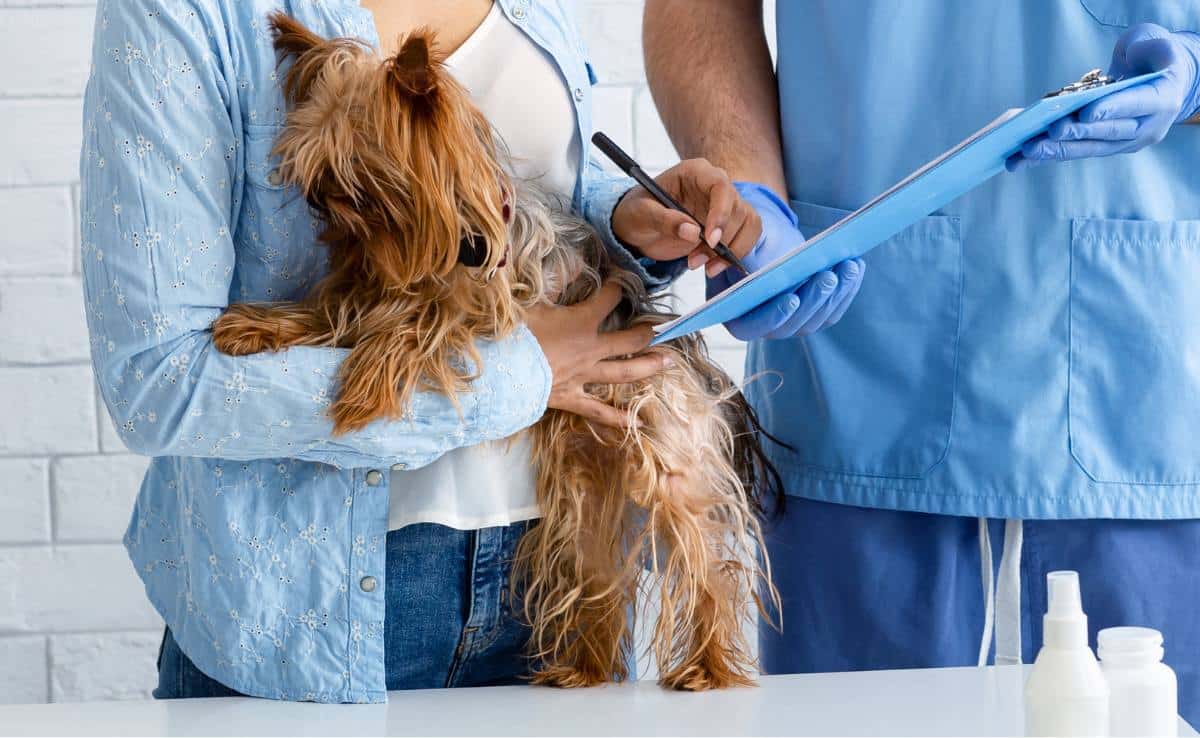Best Pet Insurance For Pomeranians
When you purchase through links on our site, we may earn a commission. Here’s how it works.

Pomeranians, also known as Poms, are small but pack a big, feisty personality. This playful, outgoing, and intelligent toy breed is among the most popular in the U.S. However, there are various health conditions Poms are susceptible to, including intervertebral disc disease (IVDD), patellar luxation, tracheal collapse, dental disease, Cushing’s disease, heart disorders, diabetes, and more.
Table of Contents
Caring for your dog’s health can be a challenging emotional and financial journey. A great way to ease some of that stress is by investing in pet insurance, which can help cover a large part of your Pomeranian’s vet bills. With a decade of experience in pet insurance and a solid understanding of breed-specific health concerns, I’m here to walk you through the typical health issues that Poms encounter and their associated costs. Plus, I can help you discover the best insurance options for your little furball.
Best Pet Insurance For Pomeranians
All purebred dogs, Pomeranians included, have specific insurance requirements. After extensive research, I’ve pinpointed this breed’s best pet insurance options. I considered several factors like coverage options, health issues related to the breed, customization possibilities, the dog’s age, premium costs, and more.
| Best For | Company | Get Quotes | Read In-Depth Reviews |
|---|---|---|---|
| Orthopedic Conditions |  | Read Review | |
| Value |  | Read Review | |
| Unlimited Payouts | Read Review | ||
| Customizable Plans |  | Read Review | |
| Most Affordable |  | Read Review | |
| Pomeranian Puppies |  | Read Review | |
| Vet Direct Pay |  | Read Review |
Best For Orthopedic Conditions: Pets Best

- Policy Options: Accident-Only, Accident & Illness, Wellness
- Annual Deductible Options: $50, $100, $200, $250, $500, $1,000
- Annual Payout Options: $5,000, $10,000, Unlimited
- Reimbursement Options: 70%, 80%, 90%
Why I Picked Pets Best
Pomeranians are prone to a variety of orthopedic issues, such as elbow and hip dysplasia, patellar luxation, Legg-Calve-Perthes disease, and IVDD. These conditions can significantly impact a dog’s mobility and overall quality of life. While many pet insurance companies have a 6-month waiting period for these orthopedic conditions, Pets Best offers a much shorter waiting period of just 14 days.
Pets Best stands out due to its wide range of policies, all offered at budget-friendly prices. They have three accident and illness coverage levels and customizable options for deductible, reimbursement percentage, and yearly payout. This level of flexibility allows you to create a policy that aligns perfectly with your financial situation. Additionally, Pets Best is one of the few insurers that offer an accident-only plan.
Expert Price Analysis
In my analysis of insurance quotes for Pomeranians of different ages and locations, Pets Best consistently provided competitive premiums compared to other companies. This held true for both basic and more comprehensive coverage options.
| Pros | Cons |
|---|---|
| Premium pricing for Poms is among the most affordable | Claim reimbursement averages 18 to 30 days |
| Offers an accident-only plan | Upgrades are required for coverage of veterinary exam costs and complementary care* |
| Covers curable pre-existing conditions once they’ve healed | |
| Get a 5% discount when insuring more than 1 pet | |
| Offers 2 optional wellness plans | |
| 14-day waiting period for orthopedic conditions (except CCL) vs. 6 months with many others | |
| No age or coverage limits for senior dogs |
In-Depth Review Of Pets Best
Check out my detailed review of Pets Best to discover more about this insurer’s various adjustable plans, coverage details, waiting periods, and other offerings.
Best Value: Fetch

- Policy Options: Accident & Illness, Wellness
- Annual Deductible Options: $250, $300, $400, $500, $600, $700
- Annual Payout Options: $5,000, $10,000, $15,000
- Reimbursement Options: 60%, 70%, 80%, 90%
Why I Picked Fetch
If you’re looking for comprehensive coverage for your Pom from head to tail, Fetch could be just what you need. Their policies offer great value, minimal exclusions, and a wide range of covered services. This includes coverage for dental issues, vet visit costs, curable pre-existing conditions, behavioral therapy, complementary treatments, and cesarean sections. Additionally, Fetch’s policies have unique perks that set it apart from other insurance providers. For instance, they include $1,000 for telehealth vet consultations, pet boarding should you require hospitalization, trip cancellation benefits if your pup falls ill, and more.
Expert Price Analysis
When I compared quotes for a policy with a $5,000 payout, 90% reimbursement, and $500 deductible, I found that Fetch’s premium pricing for Pomeranians was below average or average compared to other insurers with vet exam fee coverage added. Given its extensive benefits in all policies, Fetch is an excellent value for pet owners.
| Pros | Cons |
|---|---|
| Outstanding value considering its extensive coverage and minimal exclusions | Extended 15-day accident waiting period compared to many insurers |
| After a year without treatment or symptoms, curable pre-existing conditions are covered | Waiting period for orthopedic conditions is 6 months |
| Unique perks like virtual veterinary consultation coverage, pet boarding benefits, and more | Coverage for IVDD is excluded in some cases* |
| Optional wellness plan | No discount for insuring multiple pets |
| Can pre-approve procedures and treatment cost estimates in advance | |
| No age or coverage limits for senior dogs |
In-Depth Review Of Fetch
Be sure to see my thorough review of Fetch, which delves into its wide-ranging coverage, distinctive benefits, customization features, reimbursement process, and much more.
Best For Unlimited Payouts: Healthy Paws

- Policy Options: Accident & Illness
- Annual Deductible Options: $100, $250, $500, $750, $1,000
- Annual Payout Options: Unlimited
- Reimbursement Options: 50%, 60%, 70%, 80%, 90%
Why I Picked Healthy Paws
Considering that your Pomeranian might face several unforeseen accidents or costly genetic health issues, exploring pet insurance options that provide unlimited payouts is wise. Healthy Paws is frequently regarded as an excellent option if you’re looking for limitless coverage. Their policies come with no annual or lifetime limits, allowing for peace of mind that your coverage will never run out.
While opting for unlimited payouts raises premiums for many insurers, Healthy Paws offers competitive pricing. When you compare their plans to those from other companies that also feature unlimited annual payouts, along with similar deductibles and reimbursement rates, you’ll find that Healthy Paws can be more budget-friendly. In fact, for some Pomeranians, Healthy Paws may be a more economical choice than policies with lower payout limits.
Expert Price Analysis
It’s worth noting that Healthy Paws exclusively offers unlimited payouts, making it challenging to directly compare their premium costs with other insurance companies. However, based on the quotes I ran, I found that their pricing for Pomeranians was sometimes comparable to or slightly higher than policies from other insurers that provide a $5,000 payout and similar deductibles and reimbursements.
| Pros | Cons |
|---|---|
| All policies feature unlimited annual and lifetime payouts | Limited customization choices for older dogs |
| Reasonably priced policies for unlimited payouts and comparable coverage vs. other insurers | No ability to get coverage for veterinary exam costs or behavioral therapy |
| Claim processing takes an average of just 2 days | Some Poms aren’t insurable based on location and age |
| 15-day waiting period for IVDD and patellar luxation vs. 6 months with many others | Waiting period for hip dysplasia coverage is 12 months |
| Complementary care included in all policies | Dogs who enroll at age 6 or older are ineligible for hip dysplasia coverage |
| Long history of satisfied customers | Upper age limit for enrollment is under 14 years old |
In-Depth Review Of Healthy Paws
I recommend reading my detailed review of Healthy Paws to gain a comprehensive understanding of its benefits, customization features, speedy claim processing, waiting periods, and other features.
Best For Customizable Plans: Figo

- Policy Options: Accident & Illness, Wellness
- Annual Deductible Options: $100, $250, $500, $750
- Annual Payout Options: $5,000, $10,000, Unlimited
- Reimbursement Options: 70%, 80%, 90%, 100%
Why I Picked Figo
Figo offers a variety of options to help you design the perfect pet insurance plan for your Pom. They have three established accident and illness plans and one customizable plan — you can adjust the deductible, annual payout, and reimbursement rate to fit your spending limits. Figo also distinguishes itself by offering a 100% reimbursement option.
Additionally, all Figo policies provide extensive coverage, including dental illness, behavioral and complementary therapies, and curable pre-existing conditions. Figo’s excellent customer service, average claim processing time of three days, and short one-day accident waiting period are even more impressive.
Expert Price Analysis
In many instances, Figo offered competitive pricing for Pomeranian puppies compared to other insurance providers. However, older Pomeranians’ premiums tended to be higher than average — particularly for maximum coverage.
| Pros | Cons |
|---|---|
| Many customization options for your deductible, annual payout, and up to 100% reimbursement | Additional cost to get veterinary examination fees covered |
| Industry-leading accident waiting period of just 1 day | Waiting period for orthopedic conditions is 6 months |
| After a year without treatment or symptoms, curable pre-existing conditions are covered | |
| Optional wellness plan | |
| Every year that you don’t file a claim, your deductible drops by $50 | |
| Get a 5% discount when insuring more than 1 pet | |
| No age or coverage limits for senior dogs |
In-Depth Review Of Figo
Check out my comprehensive review of Figo to discover more about this insurance provider, including information on coverage, customization features, waiting periods, my own experiences, and more.
Most Affordable: Embrace

- Policy Options: Accident-Only, Accident & Illness, Wellness
- Annual Deductible Options: $100, $250, $500, $750, $1,000
- Annual Payout Options: $2,000, $5,000, $8,000, $10,000, $15,000, Unlimited
- Reimbursement Options: 70%, 80%, 90%
Why I Picked Embrace
Embrace’s comprehensive coverage is available for Pomeranians at very reasonable prices compared to many other insurers. All policies include coverage for complementary care, behavioral therapy, dental illness, and curable pre-existing conditions, which are often not covered or require extra fees from other providers. You can add vet exam costs, prescription meds, and a wellness plan if you want additional coverage.
Additionally, your deductible decreases by $50 each year that you don’t file a claim. While Embrace can be a bit pricey for some breeds, this is often different for Pomeranians, making it a strong contender as the best insurance provider for your Pom.
Expert Price Analysis
When I obtained quotes for Pomeranians, Embrace consistently offered affordable premium pricing for a $500 deductible, 90% reimbursement, and $5,000 payout, even with vet exam fees and prescription drugs included in the policy. The same held true in many cases for their maximum coverage option ($100 deductible, 90% reimbursement, and unlimited payout).
| Pros | Cons |
|---|---|
| Surprisingly affordable premiums for Poms for all coverage levels | Additional costs to get veterinary examination fees and prescription drugs covered |
| Get a 10% discount when insuring more than 1 pet | Some Poms are ineligible for coverage due to location and age (e.g., dogs over 5 aren’t insurable in California) |
| Every year that you don’t file a claim, your deductible drops by $50 | Waiting period for orthopedic conditions is 6 months |
| After a year without treatment or symptoms, curable pre-existing conditions are covered | Accident-only coverage is the only option for dogs enrolled at 15 years of age |
| Accident waiting period of just 2 days | |
| Offers 3 optional wellness plans |
In-Depth Review Of Embrace
Take a look at my detailed review of Embrace to better understand its broad coverage, numerous customization options, add-ons, waiting periods, and more.
Best For Pomeranian Puppies: Lemonade

- Policy Options: Accident & Illness, Wellness
- Annual Deductible Options: $100, $250, $500, $750
- Annual Payout Options: $5,000, $10,000, $20,000, $50,000, $100,000
- Reimbursement Options: 60%, 70%, 80%, 90%
Lemonade Pet Insurance Is NOT Available In: AK, DE, HI, ID, KS, KY, ME, SD, VT, WV, WY
Why I Picked Lemonade
Lemonade is a fantastic choice for Pomeranian puppies, thanks to its reasonable rates for basic coverage. Alongside competitive pricing for little Poms, this insurer provides a two-day waiting period for accidents, ensuring peace of mind if your puppy gets hurt while exploring their surroundings. Another advantage for young Poms is one of Lemonade’s optional wellness plans explicitly designed for puppies. This plan includes coverage for two wellness checkups, parasite tests, six vaccinations, spaying/neutering, and more.
It’s worth noting that Lemonade entered the pet insurance scene in 2020, so it doesn’t have the long track record of the other companies mentioned in this article. Nevertheless, it has rapidly established a strong reputation.
Expert Price Analysis
Based on the quotes I ran, Lemonade consistently provided some of the most budget-friendly premiums for Pomeranian puppies and often for adult dogs. Their base rates remain competitive, even when factoring in coverage for veterinary exam fees. However, their maximum coverage with all add-ons included was often above average compared to similar coverage from other insurers.
| Pros | Cons |
|---|---|
| Affordable pricing for Pom puppies for lower to mid-level coverage | Unavailable in 12 states |
| Get a 5% discount when insuring more than 1 pet | Coverage for veterinary exam costs, dental illness, complementary care, and behavioral therapy all require add-ons |
| Claim processing takes an average of just 2 days | |
| After a year without treatment or symptoms, curable pre-existing conditions are covered | |
| Offers 2 optional wellness plans | |
| 30-day waiting period for orthopedic conditions (except CCL) vs. 6 months with many others |
In-Depth Review Of Lemonade
See my comprehensive review of Lemonade for additional information about this provider’s base plan, optional add-ons, numerous customization choices, and other features.
Best For Vet Direct Pay: Trupanion

- Policy Options: Accident & Illness
- Lifetime Per-Condition Deductible Options: $0 – $1,000 (in $5 increments)
- Annual Payout Options: Unlimited
- Reimbursement Options: 50%, 60%, 70%, 80%, 90%, 100%
Why I Picked Trupanion
Trupanion stands out as the only pet insurance provider that can directly cover its share of your vet bill at the time of checkout. Their VetDirect Pay system can be easily integrated into your veterinarian’s office, removing the need for you to deal with reimbursement later. If your vet still needs to set up this software, they can reach out to Trupanion for installation, allowing you to take advantage of this convenient feature. Given that Pomeranians often face costly health issues, VetDirect Pay can greatly alleviate your worries about managing veterinary expenses during diagnosis and treatment.
Expert Price Analysis
While comparing quotes for Pomeranian insurance, I noticed that Trupanion’s premiums were significantly higher, often three to four times more than those from other companies offering similar coverage.
| Pros | Cons |
|---|---|
| All policies feature unlimited annual and lifetime payouts | Pomeranian pricing is much higher than other insurers |
| VetDirect Pay feature relieves you of having to wait for reimbursement | No ability to get coverage for veterinary exam costs |
| 30-day waiting period for orthopedic conditions vs. 6 months with many others | Long waiting period of 30 days for illnesses |
| After a year without treatment or symptoms, curable pre-existing conditions are covered | Upper age limit for enrollment is under 14 years old |
| Claim processing is done within 2 days on average |
In-Depth Review Of Trupanion
If you’re interested in a deeper dive into this provider’s one-of-a-kind VetDirect Pay feature, insurance options and benefits, waiting periods, and more, read my detailed review of Trupanion.
What Type Of Pet Insurance Plan Is Best For Pomeranians?
Pet insurance generally falls into two primary categories: accident-only plans and comprehensive plans covering accidents and illnesses. Moreover, some companies provide optional wellness plans. While these aren’t classified as insurance, they can be an excellent way to help manage expenses for routine checkups and preventive care, keeping your Pom in great shape.
| Accident-Only | Accident & Illness | Wellness | |
|---|---|---|---|
| Injuries (head and eye trauma, bowel obstruction, wounds, sprains, bone fractures, etc.) | |||
| Diseases (tracheal collapse, diabetes, patellar luxation, IVDD, dental illness, heart disorders, etc. ) | |||
| Preventative (wellness exams, routine bloodwork, vaccinations, parasite prevention, dental cleaning, etc.) |
What Are Accident-Only Pet Insurance Plans?
Accident-only plans are an excellent option for dog owners who want to ensure their pets receive emergency care for injuries like accidental poisoning, cuts, fractures, eye trauma, and foreign body ingestion, all while staying within a tight budget. These plans are also ideal for pets with pre-existing conditions that are usually not covered by accident and illness policies. However, it’s worth noting that only a few insurance providers offer accident-only policies.
Pricing Tip – Plans that only cover accidents usually have substantially lower premiums than those that cover illnesses and accidents.
What Are Accident & Illness Pet Insurance Plans?
Accident and illness plans provide your dog with top-notch health insurance protection. These policies cover not just injuries but also a variety of illnesses and genetic issues that can impact Pomeranians, such as patellar luxation, IVDD, skin disorders, tracheal collapse, Cushing’s disease, hypothyroidism, bladder stones, and others. With this insurance, you’ll be ready for almost any health challenge your beloved pet may face.
What Are Wellness Plans?
Incorporating a wellness plan into your pet insurance is a smart way to take charge of your pet’s health. These plans help cover expenses for essential preventive care, including yearly checkups, vaccinations, dental cleanings, and more. By having a wellness plan in place, you can ease financial concerns and promote better health for your furry friend.
Keep in mind that wellness plans differ from pet insurance; they focus solely on preventive care and do not cover expenses related to illnesses or accidents.
What Does Pet Insurance Cover & Exclude?
When it comes to accident and illness insurance plans, most providers typically include the following items for medical treatment as determined necessary by a vet. However, it’s essential to keep in mind that coverage can vary between providers. Each insurer may have specific limitations on certain conditions, so it’s crucial to carefully review your policy to ensure you understand the extent of your coverage.
| Covered | Excluded |
|---|---|
| Blood tests | Boarding |
| Cancer (chemo & radiation) | Cremation & burial costs |
| CT scans | Elective procedures (e.g., declawing, ear cropping, spaying/neutering, tail docking, etc.) |
| Chronic conditions | Food & supplements |
| Congenital conditions | Grooming |
| Emergency care | Pre-existing conditions* |
| Euthanasia | Pregnancy & breeding |
| Hereditary conditions | Vaccines |
| MRIs | |
| Non-routine dental treatment | |
| Prescription medications | |
| Rehabilitation | |
| Specialized exams & care | |
| Surgery & hospitalization | |
| Ultrasounds | |
| X-rays |
Learn More About Pet Insurance Coverage
I recommend reading my in-depth guide on pet insurance coverage because it can be challenging to understand what pet insurance does and does not cover.
What Determines The Cost Of Pet Insurance For Pomeranians?

Pet insurance companies take into consideration many factors when setting premium prices.
- The cost of pet insurance is significantly impacted by your dog’s age. Younger dogs typically have cheaper insurance rates because they are less likely than older dogs to develop expensive health problems like cataracts and IVDD.
- Premium rates are also significantly impacted by the cost of living in your area. Variations in local living costs affect veterinary professionals and pet owners equally. As a result, veterinary care and pet insurance will likely cost more if you live in a high-cost area.
- Furthermore, a dog’s breed is a significant factor. Purebred dogs frequently face greater health risks than mixed breeds, which raises the cost of insurance. Certain breeds are more likely to experience particular health issues.
- A dog’s gender can also affect premium rates. Male dogs tend to be bigger than females, which can lead to a need for more medication, advanced medical equipment, and extra supplies, resulting in higher insurance costs. That said, it’s worth mentioning that some insurance providers do not consider gender when determining their rates.
You might have little control over some factors that influence your policy’s cost, but there are plenty of options to tailor your pet insurance plan to suit your needs and budget. Let’s explore how you can take advantage of policy customizations.
Customization Options Affect Cost & Benefits
Many pet insurance companies offer a variety of adjustable features to cater to your budget requirements and the specific needs of your Pomeranian. You have the option to choose a policy that solely covers accidents or one that also includes illnesses. Furthermore, you can customize the deductible, the percentage of reimbursement, and the maximum amount you can receive. Understanding the effects of each adjustment on your benefits and coverage is crucial.
What Is A Maximum Payout?
The pet insurance industry has two types of payouts: annual and lifetime. An annual payout represents the maximum limit that the insurance provider will pay for your pet’s healthcare expenses within a policy year. On the other hand, a lifetime cap refers to the total amount that the insurer will cover for your pet’s treatment throughout their insured lifetime. The companies mentioned in this article offer annual payouts with common choices of $5,000, $10,000, and unlimited.
Pricing Tip – If you choose a lower payout option, your monthly premium will decrease. Keep in mind, though, that if your dog’s veterinary bills go beyond your annual limit, you’ll need to pay the additional costs out of pocket.
What Is A Deductible?
The deductible refers to the predetermined amount you must pay out of your pocket before your insurance company steps in to cover the costs of your pet’s veterinary care. Most providers have an annual deductible, but Trupanion takes a different approach by implementing a deductible that is applied per condition. Typical deductibles are $100, $250, or $500, but they can range anywhere from $0 to $1,000. Let’s take a closer look at how each type of deductible works.
- Annual deductible: With an annual deductible, you pay a fixed amount each policy year, regardless of how many health issues your dog may experience or the treatments they require. This provides predictability and allows you to better budget and manage your pet’s healthcare costs.
- Lifetime per-condition deductible: A per-condition deductible requires you to pay a deductible for each new medical problem or emergency that your pet faces. This means that if your dog has multiple health issues in a year, the deductible can accumulate quickly. However, there is a silver lining for ongoing chronic conditions like diabetes, Cushing’s disease, epilepsy, and hypothyroidism. In these cases, you only need to pay the deductible once for that specific condition during your pet’s insured lifetime.
Pricing Tip– Opting for a higher deductible means you’ll have to cover more costs out of pocket for your dog’s medical care initially, but it will reduce your monthly premium.
What’s The Reimbursement Percentage?
The portion of your veterinary bills that your insurance company will cover after you meet your deductible depends on your selected reimbursement rate. For example, if you choose a $100 deductible and a 90% reimbursement rate, you will be responsible for the initial $100 as well as 10% (known as your copay) of the total veterinary bill. The insurer will reimburse you for the remaining 90%. Reimbursement options typically include 70%, 80%, and 90%.
Pricing Tip – Choosing a higher reimbursement percentage means your monthly premium will increase, but you’ll pay less out of pocket when your dog needs medical treatment.
Learn More About Pet Insurance Costs
See my in-depth article on pet insurance costs for a thorough understanding of how customization choices affect your coverage and premium rates.
How Much Is Pet Insurance For A Pomeranian?
Enter your zip code and Pom’s information in the form below to get personalized pet insurance quotes from several highly rated companies. This will help you find the most accurate pricing for your furry friend. I’ve also gathered sample quotes for Pomeranians to illustrate how the prices stack up, but the best approach is to obtain a quote for your own dog.
According to NAPHIA (North American Pet Health Insurance Association), the average monthly premium for an accident and illness dog insurance policy in the U.S. is $62.44 ($32.10 for cats).
I ran several insurance quotes for Pomeranians, considering different locations and ages, to provide you with a snapshot of the average insurance costs. These quotes feature similar customization options, allowing for a more precise comparison of premium prices among various providers.
| Company | 6mo old male 95818 (Sacramento, CA) | 1yr old female 14211 (Buffalo, NY) | 2yr old male 33604 (Tampa, FL) | 5yr old female 78731 (Austin, TX) | 8yr old male 07305 (Jersey City, NJ) |
|---|---|---|---|---|---|
 | $33.01 | $22.06 | $25.27 | $40.72 | $105.26 |
 | $40.59 | $29.93 | $35.96 | $63.64 | $95.54* |
| $43.13*§ | $26.47*§ | $31.90*§ | $55.26*§ | $61.13†§ | |
 | $36.82 | $36.57 | $29.22 | $48.78 | $110.57 |
 | $23.04 | $27.29 | $23.04 | $35.50 | $53.18 |
 | $31.95 | $26.14 | $24.45 | $22.29 | $59.62 |
 | $78.14§ | $95.01§ | $201.51‡§ | $134.80§ | $249.67§ |
*80% reimbursement; †50% reimbursement and $1,000 deductible (no other options); ‡$0 deductible; §Unlimited annual payouts
Pomeranian Insurance Cost: Lowest & Highest Amounts
I also gathered quotes reflecting the same companies’ lowest and highest insurance premiums to further analyze costs. These quotes take into account the annual payout, reimbursement rates, deductibles, and additional features (excluding wellness plans). I included two different ages of Pomeranians to demonstrate how insurance costs can vary based on a dog’s age at enrollment.
| Company | 2mo old 95818 (Sacramento, CA) | 5yr old 95818 (Sacramento, CA) | 2mo old 14211 (Buffalo, NY) | 5yr old 14211 (Buffalo, NY) | 2mo old 33604 (Tampa, FL) | 5yr old 33604 (Tampa, FL) | 2mo old 78731 (Austin, TX) | 5yr old 78731 (Austin, TX) | 2mo old 07305 (Jersey City, NJ) | 5yr old 07305 (Jersey City, NJ) |
|---|---|---|---|---|---|---|---|---|---|---|
 | $15-$92 | $19-$116 | $10-$63 | $12-$79 | $13-$83 | $15-$96 | $16-$89 | $18-$103 | $22-$124 | $25-$144 |
 | $27-$67 | $45-$115 | $22-$44 | $36-$79 | $24-$53 | $41-$93 | $26-$56 | $44-$98 | $25-$47 | $42-$82 |
| $26-$51 | $37-$74 | $20-$32 | Uninsurable | $14-$35 | $26-$65 | $28-$54 | $42-$66 | $25-$39 | $36-$57 | |
 | $16-$96 | $21-$124 | $15-$114 | $20-$149 | $12-$91 | $17-$132 | $13-$101 | $19-$147 | $20-$132 | $27-$172 |
 | $9-$89 | Uninsurable | $10-$83 | $10-$85 | $9-$59 | $12-$77 | $11-$72 | $14-$94 | $11-$74 | $15-$97 |
 | $16-$121 | $18-$132 | $16-$101 | $17-$108 | $17-$121 | $18-$132 | $17-$87 | $16-$85 | $19-$111 | $20-$120 |
 | $47-$193 | $95-$415 | $51-$209 | $86-$373 | $52-$154 | $111-$330 | $42-$170 | $81-$351 | $50-$205 | $99-$433 |
What Are Waiting Periods For Pomeranian Pet Insurance?
The time between enrolling in an insurance plan and the beginning of your coverage is known as the waiting period, and it can vary depending on the insurance company.* While waiting periods for illnesses typically last 14 days, they can range from 0 to 15 days for accidents. But for orthopedic disorders like hip dysplasia, IVDD, and patellar luxation—all of which are common in Pomeranians—many insurers have longer waiting periods.
*States are gradually adopting a Model Law for pet insurance, aiming to standardize regulations, including uniform waiting periods. In California, Delaware, Louisiana, Maine, Mississippi, Nebraska, New Hampshire, Washington, Rhode Island, and Maryland, waiting periods are:
- Accidents: 0 days
- Illnesses: 14 days
- Cruciate Ligament Conditions: 30 days
- Routine Care: 0 days
Learn More About Waiting Periods
Find out the rationale behind waiting periods for pet insurance and other important details.
How Does Pet Insurance For Pomeranians Work?
Using your pet insurance is simple after the waiting periods outlined in your policy have passed.
- Pay your veterinarian’s bill after your dog receives treatment.
- Provide your insurance company with a claim form and a thorough receipt. Because some insurance companies need your veterinarian’s signature, bringing a copy of your claim form to your appointment could be helpful.
- Once the insurance company approves your claim, you will receive your reimbursement* by the payment method you choose, such as a check, direct deposit, or another method.
* The time frame for reimbursement can vary greatly, ranging from a few minutes to several weeks. The intricacy of your claim and the company’s established processing time affect this variance.
16 Health Issues In Pomeranians

Pomeranians usually have a lifespan of around 12 to 16 years. Like many purebred dogs, they are more prone to specific health problems compared to mixed breeds. When considering pet insurance’s advantages for your Pomeranian, it’s essential to be aware of the potential health issues and the financial obligations that may arise.
- According to research, Pomeranians are one of the breeds most likely to experience kneecap dislocation or patellar luxation. This condition affects both hind knees in over 50% of affected dogs. These chronic knee problems often necessitate surgery, costing between $1,500 and $3,000 per knee.
- Elbow and hip dysplasia, which happens when the bones don’t align correctly with the joint socket, is a common problem for Poms. Surgical intervention is often necessary, costing anywhere from $1,700 to $4,500 or more for each affected joint.
- Poms and other small breeds are prone to Legg-Calve-Perthes disease early in life. This inherited condition causes the hip joint to collapse due to the deterioration of the femur head. Hip surgery, medication, and post-operative rehabilitation are typically part of the treatment, which can cost between $2,000 and $4,000 per hip joint.
- Intervertebral disc disease (IVDD) is a condition in which the discs between the vertebrae shift into the spinal canal, and this breed is especially prone to it. Options for diagnosing and treating this issue include MRIs, X-rays, medications, surgeries, regular checkups, and physical therapy. The costs for these treatments typically range from $3,000 to $8,000.
- Tracheal collapse occurs when the cartilage in the trachea becomes weak. The cost of diagnosis can vary from $500 to $2,000, and if surgery is needed to reinforce the windpipe, the total expenses could increase by an additional $2,000 to $5,000.
- Pomeranians are at risk for hydrocephalus, a condition associated with a soft spot on their skull known as a molera. This occurs when spinal fluid builds up around the brain, which can result in symptoms such as seizures, coordination difficulties, and other neurological issues. To help manage seizures and decrease brain inflammation, monthly medications usually cost around $50. If surgery is needed, it typically requires the expertise of veterinary specialists and can be expensive, ranging from $5,000 to $10,000.
- Poms are particularly vulnerable to early-onset dental disease due to their small jaws and overcrowded teeth. Gum disease prevention is the best course of action. Developing an at-home dental hygiene routine is essential in addition to professional dental cleanings, which can cost between $300 and $700 annually (which a wellness plan can help cover).
- Cushing’s disease occurs when the body produces too much cortisol. Treatment usually involves medications and diet adjustments. The cost of diagnosis can be significant, averaging between $500 and $1,500, while medication expenses can range from $50 to $200 per month (for life).
- Hypoglycemia occurs when blood sugar levels fall too low, and it is often seen in small dog breeds and puppies. To diagnose and treat this condition, veterinarians may perform imaging and blood glucose tests and provide oral liquid glucose or IV fluids. Treatment costs vary widely, ranging from $80 to $8,000, depending on the severity and underlying issues.
- Pomeranians are susceptible to two heart conditions: patent ductus arteriosus (PDA) and mitral valve disease. If these issues are identified early, the expenses for diagnosing and treating PDA can range from approximately $2,500 to $5,000, while medication for mitral valve disease typically costs between $500 and $2,000. Surgical treatment for mitral valve disease generally averages around $30,000.
- Pomeranians, particularly overweight ones, are predisposed to diabetes, a chronic condition marked by the body’s inability to adequately regulate blood sugar levels. Diagnostic testing can cost up to $500. Diabetic dogs require daily insulin injections, which can cost up to $80 a month for life. They also need two to four annual veterinary visits and routine blood and urine testing.
- Pomeranians are susceptible to various inherited eye issues, including cataracts, entropion, and distichiasis. Cataract surgery usually costs $2,600 to $3,800, while entropion and distichiasis (eyelid disorders) can cost upwards of $1,500 per eye to treat.
- This breed is susceptible to a genetic issue known as hyperuricosuria, which can lead to the formation of bladder stones—crystallized minerals that can get stuck in the bladder. If there are several stones or if they are particularly large, surgery might be necessary, and the expenses can reach as high as $3,000.
- Yet another genetic concern found in this breed is autoimmune thyroiditis, which can result in hypothyroidism. This condition occurs when the thyroid gland doesn’t produce enough hormones, necessitating ongoing medication and regular checkups. Lifelong medication costs usually fall between $20 and $50 per month. Initial diagnostic testing costs up to $150, and annual retesting ranges from $50 to $100.
- Pomeranians frequently experience skin issues, including Alopecia X, which leads to hair loss, and sebaceous adenitis, a chronic condition that causes skin infections, hair loss, and flaking, necessitating ongoing care. The monthly costs for topical creams, medicated baths, and oral medications amount to about $50. Treating chronic skin infections over a dog’s lifetime can exceed $2,000.
- Epilepsy causes irregular electrical signals in a dog’s brain, leading to seizures. For uncomplicated cases, you can expect to spend about $500 to $1,000 yearly on medications and regular vet visits. However, more complex cases might require more frequent checkups and pricier medications, with annual costs varying between $1,000 and $5,000.
Is Pet Insurance Worth It For Pomeranians?
Here are some statistics to keep in mind. According to the Orthopedic Foundation for Animals (OFA) breed health survey conducted among Pomeranian owners and breeders regarding vet-diagnosed conditions, 29% of owners reported orthopedic issues, 25% faced dental problems, 21% encountered skin conditions, and 15% dealt with respiratory disorders.
The OFA’s 2023 testing data reveals that almost 30% of Pomeranians tested positive for patellar luxation, around 19% for hip dysplasia, over 5% for advanced cardiac issues, and 25% for at least one eye abnormality.
As you can see, Pomeranians are susceptible to costly health concerns, making pet insurance essential. With insurance, you can ensure your beloved pet receives the necessary medical attention in case of unforeseen illnesses or emergencies. Remember that most pet insurance policies do not cover pre-existing conditions, so it’s a good idea to insure your dog before any health issues come up.
Determine If Your Pomeranian Needs Insurance
To help you weigh the benefits and drawbacks of investing in pet insurance, read my guide on whether pet insurance is worth it.
5 Steps To Find The Best Pet Insurance For Pomeranians
When choosing the best insurance plan for your Pom, there are a few important factors to take into account.
- Examine the standing of each insurance company you’re considering. In general, reputable providers with a strong track record are more trustworthy than those who have only been in business for a few years.
- Learn about the common health issues that Poms may encounter, and carefully read the policy’s details to see how each condition is addressed.
- Think about whether you would prefer a more complete plan that covers illnesses and accidents or coverage that only covers accidents.
- Understanding the reimbursement procedure and the typical turnaround time for each provider’s claims is also essential.
- Finally, to properly compare pet insurance costs, obtain quotes from a minimum of three insurance providers.
Methodology
To determine the best pet insurance for Pomeranians, we analyzed more than 40 U.S. pet insurance companies to provide an unbiased breakdown of how providers compare against one another. Our in-depth research includes:
- Running thousands of price quotes
- Reading hundreds of customer reviews
- Scrutinizing every policy from top to bottom and reading all the fine print
- Scoping out the purchase process
- Speaking with customer service representatives
- Having firsthand experience submitting claims with companies
- Comparing plan customization details
- Examining how long it takes to receive reimbursement
- Factoring in company history and years in the pet insurance marketplace
- Meeting with company representatives to discuss changes related to the industry, their company, and their offerings
- Requiring national experience for companies
Unlike many other review sites, we refuse to let pet insurance companies pay for the top spot in our rankings. Companies must earn their position in our comparisons by performing well in the marketplace. We also point out each company’s pros and cons in light of their competitor’s strengths. In doing so for over a decade, we’ve helped pet parents make more educated decisions among the top pet insurance options. Pet insurance providers read our reviews, regularly check them for accuracy, and value our input to help create positive industry changes and better protect your pets. We only recommend the best of the best because it’s what our readers deserve.
Additional Pet Insurance Resources
- Best Pet Insurance
- Is Pet Insurance Worth It?
- What Does Pet Insurance Cover?
- How Much Does Pet Insurance Cost?
- Best Pet Insurance For Pre-Existing Conditions
Why Trust Canine Journal?
Canine Journal has been covering the topic of pet insurance since 2012, well before other conglomerates discovered the rising popularity of health care for our pets. Many of our authors have personal experience with pet insurance, including Kimberly Alt, who has been Canine Journal’s go-to writer for pet insurance for over a decade, having written about nearly every possible facet related to pet insurance. Kimberly knows the subject so well that she can answer a breadth and depth of pet insurance questions immediately. And on the rare occasion she doesn’t know the answer off the top of her head, she can find it within minutes due to her vast list of resources. Kimberly also has extensive knowledge of dog health conditions, which can help her recommend pet insurance providers to pet owners with specific breeds.
Kimberly collaborated with Sally Jones, a seasoned health sciences communications professional with decades of experience. Sally specializes in dog health and is adept at producing content on technical topics such as pet insurance. Her wealth of knowledge and insight played a crucial role in this article’s thorough research and composition.
Kimberly also consulted with Michelle Schenker, Canine Journal’s in-house licensed insurance agent, for additional expertise to ensure accuracy and give Canine Journal the authority to write about and assist readers in purchasing policies that are accurately represented.



